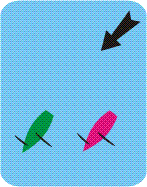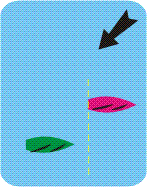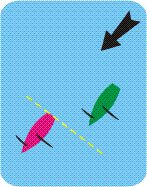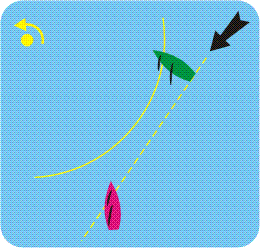|
If 10 rules for racing is about 6 more than you're comfortable with, here is the absolute minimum.
The first three rules are given in order of priority. The fourth rule is the exception when you round a mark. In the diagrams, the red boat has right of way, and the green boat is the give-way
boat.
| |
|
|
 
|
1 Port keeps clear of starboard
You are on starboard when the wind is on your right side. Equivalently, your main boom lies over the left side of the boat.
This is relatively straightforward when beating into the wind.
On the run, however, the wind might not be clearly on one side or other of a boat, and in this case the main boom tells you which tack
you are on.
Regardless of the rules about "windward / leeward" and "ahead / astern", the starboard tack boat has right of way
over the port tack boat.
|
|
 
|
2 Windward keeps clear of leeward
You are leeward when the other boat is closer to the direction the wind is coming from
than you. Equivalently, the windward boat's main boom
is pointing towards you (and you are leeward if your main boom is pointing away
from the other boat). Again, this is relatively straightforward when beating.
Sometimes it may not be clear which boat is closer to the wind's direction than another, particularly when the boats are both
running. In this case, the leeward boat is the boat whose main boom lies away from the other boat. In the illustration on the
right, although the red boat "seems" to be to windward, it is in fact the leeward boat.
This rule applies when the two boats are on the same tack, either on port or on starboard. (If the boats are not on the same tack,
then the "port / starboard" rule applies.)
|
|
 
|
3 Astern keeps clear of a boat ahead
You are ahead when the other boat is completely behind a line drawn at right angles to your transom.
This rule applies when the two
boats are on the same tack, either on port or on starboard. (If the boats are not on the same tack, then the "port / starboard"
rule applies.)
|
| Notice that there is an interesting situation when one boat is running, and the other boat is beating, and they are moving towards each
other. In this case, neither boat is clear ahead. If the two boats are on the same tack, then the rule about "windward /
leeward" applies -- the running boat must keep clear of the beating boat. If the two boats are on different tacks, then the boat
on port must keep clear -- and the boat on port could be the beating boat.

|
|

|
4 Give room to (all) the inside boat(s) to round
the mark
This rule applies starting at four
boat-lengths from the mark. This area is called the "zone".
A boat is inside if it is not completely behind a line drawn at right angles to your transom. The question of whether it is inside
is judged when you are four
boat-lengths from the mark.
There are a number of wrinkles to this rule when you read it in detail, but this is the gist of it. The inside boat is entitled to
mark room all the way round the mark while you remain in the zone.
This rule over-rides the "windward / leeward" rule. The
inside boat always has mark room.
The boat which is ahead when it enters the zone is entitled to mark room,
even if another boat gains an overlap inside the zone.
Now the "port / starboard" rule counts as long as
the boats are beating to windward on opposite tacks even when one or both enters the zone. Put simply, there isn't a zone when boats are on opposite tacks
approaching a windward mark.
As John Ball notes, however: "There is a zone for boats on
opposite tack (gybe) at a downwind mark", and so this rule over-rides the
"port / starboard" rule when running boats on opposite tack arrive at the zone of a
leeward mark. |
Of course, if you'd prefer a more complete set of basic rules, without going
the whole nine yards, here is a suggestion for a guide.
2008-09-29 |
